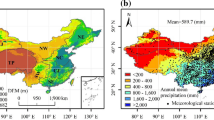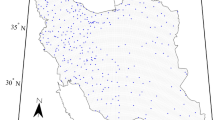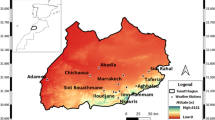Abstract
This study evaluated the performance of three versions of Global Satellite Mapping of Precipitation (GSMaP) products at 0.1° spatial resolution for monitoring meteorological drought over Iran. The investigated GSMaP products included the gauge-corrected product (GSMaP-Gauge), the standard MW-IR combined product (GSMaP-MVK), and the near-real-time product (GSMaP-NRT), examined during the period from 1 March 2014 to 31 December 2018. For reference, we used high-quality ground-observed precipitation data from 344 synoptic stations. The standard precipitation index (SPI) on different timescales from 1 to 12 months was used for the quantification of drought events. The statistical metrics employed for the assessment of the performance of the three GSMaP products included Pearson’s correlation coefficient (R) and root mean square error (RMSE). In addition to the evaluations based on spatial and temporal scales, the capability of the GSMaP products of identifying drought events was considered. The results indicated that GSMaP-Gauge was superior to the other two GSMaP products in the monitoring of drought patterns over Iran, with a much higher R and a much lower RMSE, particularly on long timescales. In spatial terms, all the three GSMaP products exhibited high performance in Western Iran, where precipitation is high. Generally, the study revealed the potential capability of GSMaP products for monitoring meteorological drought over Iran, particularly for data-poor or ungauged basins.











Similar content being viewed by others
Data availability
The GSMaP data is available at ftp://rainmap:Niskur+1404@hokusai.eorc.jaxa.jp/. The observation data used in this study has not been released.
Code availability
Not applicable.
References
AghaKouchak A, Farahmand A, Melton FS, Teixeira J, Anderson MC, Wardlow BD, Hain CR (2015) Remote sensing of drought: progress, challenges and opportunities. Rev Geophys 53:452–480. https://doi.org/10.1002/2014RG000456
Belayneh A, Adamowski J, Khalil B, Ozga-Zielinski B (2014) Long-term SPI drought forecasting in the Awash River Basin in Ethiopia using wavelet neural network and wavelet support vector regression models. J Hydrol 508:418–429
Brown SJ, Caesar J, Ferro CAT (2008) Global changes in extreme daily temperature since 1950. Clim Dyn 113:D05115. https://doi.org/10.1029/2006JD008091
Darand M (2020) Spatiotemporal analysis of the relationship between near‐surface air temperature and troposphere thickness over Iran. Meteorol Appl 27(2):e1907-(1–13)
Darand M, Amanollahi J, Zandkarimi S (2017) Evaluation of the performance of TRMM Multi-satellite Precipitation Analysis (TMPA) estimation over Iran. Atmos Res 190:121–127
Darand M, Khandu K (2020) Statistical evaluation of gridded precipitation datasets using rain gauge observations over Iran. J Arid Environ 178, 104172.
Deng P, Mingyue Zh, Bing J, Jia J, Zhang D (2019) Evaluation of the GSMaP_Gauge products using rain gauge observations and SWAT model in the Upper Hanjiang River Basin. Atmos Res 219:153–165
Deng P, Mingyue Zh, Guo H et al (2018) Error analysis and correction of the daily GSMaP products over Hanjiang River Basin of China. Atmos Res 214:121–134. https://doi.org/10.1016/j.atmosres.2018.07.022
Dutta D, Kundu A, Patel NR (2013) Predicting agricultural drought in eastern Rajasthan of India using NDVI and standardized precipitation index. Geocarto Int 28:192–209
Dutta D, Kundu A, Patel NR, Saha SK, Siddiqui AR (2015) Assessment of agricultural drought in Rajasthan (India) using remote sensing derived Vegetation Condition Index (VCI) and Standardized Precipitation Index (SPI). Egypt J Remote Sens Space Sci 18:53–63
Garcia-Leon D, Contreras S, Hunink J (2019) Comparison of meteorological and satellite-based drought indices as yield predictors of Spanish cereals. Agric Water Manag 213:388–396
Gottardi F, Obled C, Gailhard J, Paquet E (2012) Statistical reanalysis of precipitation fields based on ground network data and weather patterns: application over French mountains. J Hydrol 432–433:154–167. https://doi.org/10.1016/j.jhydrol.2012.02.014
Guo H, Bao A, Liu T, Chen Sh, Ndayisaba F (2016) Evaluation of PERSIANN-CDR for meteorological drought monitoring over China. Remote Sens 8, 379; doi:https://doi.org/10.3390/rs8050379
Hayes MJ, Svoboda MD, Wilhite DA, Vanyarkho OV (1999) Monitoring the 1996 drought using the standardized precipitation index. Bull Amer Meteor Soc 80:429–438
Heim RR (2002) A review of twentieth-century drought indices used in the United States. Bull Am Meteorol Soc 83:1149–1165
Hobouchian MP, Salio P, Skabar YG, Vila D, Garreaud R (2017) Assessment of satellite precipitation estimates over the slopes of the subtropical Andes. Atmos Res 190:43–54. https://doi.org/10.1016/j.atmosres.2017.02.006
Joyce RJ, Janowiak JE, Arkin PA, Xie P (2004) CMORPH: A method that produces global precipitation estimatesfrom passive microwave and infrared data at highspatial and temporal resolution. J Hydrometeor 5:487–503
Kubota T, Shige S, Hashizume H, Aonashi K, Takahashi N, Seto S, Hirose M, Takayabu YN, Ushio T, Nakagawa K, Iwanami K, Kachi M, Okamoto K (2007) Global precipitation map using satellite-borne microwave radiometers by the GSMaP project: production and validation. IEEE Trans Geosci Remote Sens 45(7):2259–2275
Li D, Christakos G, Ding X et al (2017) Adequacy of TRMM satellite rainfall data in driving the SWAT modelling of Tiaoxi catchment (Taihu lake basin, China). J Hydrol 556:1139–1152. https://doi.org/10.1016/j.jhydrol.2017.01.006
Lo Conti F, Hsu K-L, Noto LV, Sorooshian S (2014) Evaluation and comparison of satellite precipitation estimates with reference to a local area in the Mediterranean Sea. Atmos Res 138:189–204
Mantas VM, Liu Z, Caro C, Pereira AJSC (2015) Validation of TRMM multi-satellite precipitation analysis (TMPA) products in the Peruvian Andes. Atmos Res 163:132–145. https://doi.org/10.1016/j.atmosres.2014.11.012
McKee T.B, Doesken N.J, Kleist J (1993) The relationship of drought frequency and duration to time scale. In: Proceedings of the Eighth Conference on Applied Climatology, Anaheim, California,17–22 January 1993. Boston, American Meteorological Society, 179–184.
McKee T.B, Doesken N.J, Kleist J (1995) Drought monitoring with multiple timescales. In: Proceedings of the Ninth Conference on Applied Climatology, Dallas, Texas, 15–20 January 1995. Boston Am Meteorol Soc, 233–236.
Mega T, Ushio T, Kubota T, Kachi M, Aonashi K, Shige S (2014) Gauge adjusted global satellite mapping of precipitation (GSMaP_Gauge), in Proc. Gen. Assem. Sci. Symp.
Poonia S, Rao A.S (2012) Analysis of meteorological drought at arid Rajasthan using standardized precipitation index. In: 92nd America. Meteorol. Soc. Annual. Meet, 22–26.
Seto S, Tsunekawa T, Oki T (2012) A new rain detection method to complement high-resolution global precipitation products. Hydrol Res Lett 6:82–86
Shrestha NK, Qamer FM, Pedreros D, Murthy MSR, Md WS, Shrestha M (2017) Evaluating the accuracy of Climate Hazard Group (CHG) satellite rainfall estimates for precipitation based drought monitoring in Koshi basin. Nepal J Hydrol 13:138–151
Taylor KE (2001) Summarizing multiple aspects of model performance in a single diagram. J Geophys Res 106(D7):7183–7192
Tustison B, Harris D, Foufoula‐Georgiou E (2001) Scale issues in verification of precipitation forecasts. J Geophys Res 106(D11):11 775–11–784. https://doi.org/10.1029/2001JD900066
Ushio T, Aonashi K, Kubota T, Shige S, Kachi M, Oki R, Okamoto K, Yoshida S, Morimoto T, Kawasaki Z (2013) Global Satellite Mapping of Precipitation (GSMaP) project. Int Water Technol J 3:192–196
Ushio T, Sasashige K, Kubota T, Shige S, Okamoto K, Aonashi K, Inoue T, Takahashi N, Iguchi T, Kachi M, Oki R, Morimoto T, Kawasaki Z-I (2009) A Kalman filter approach to the Global Satellite Mapping of Precipitation (GSMaP) from combined passive microwave and infrared radiometric data. J Meteorol Soc Jpn 87A:137–151
Wilhite D.A (2005) Drought and Water Crises: Science, Technology, and Management Issues, pp. 432, vol. 86, CRC Press.
WMO (2009) Inter-Regional workshop on indices and early warning systems for drought. Lincoln, NE, Dec. 2009, Geneva: World Meteorological Organization.
WMO (2012) Standardized precipitation index user guide (WMO-No.1090), Geneva. http://www.droughtmanagement.info/literature/WMO_standardized_precipitation_index_user_guide_en_2012.pdf
Xie P, Yatagai A, Chen M et al (2007) A gauge-based analysis of daily precipitation over East Asia. J Hydrometeorol 8(3):607
Zambrano-Bigiarini M, Manuel Baez-Villaneuva O (2019) Extreme hydroclimatic events and multivariate hazards in a changing environment a remote sensing approach 221–246.
Zhang A, Jia G (2013) Monitoring meteorological drought in semiarid regions using multi-sensor microwave remote sensing data. Remote Sens Environ 134:12–23
Zhu Z, Yong B, Ren L (July 2018) Chen X (2018) Tracing the error sources of global satellite mapping of precipitation for GPM (GPM-GSMaP) over the Tibetan Plateau. China, IEEE Journal of Selected Topics in Applied Earth Observations and Remote Sensing 11:7
Acknowledgements
We extend our sincere gratitude to the Japan Aerospace Exploration Agency (JAXA) for making GSMaP precipitation data available for this work and to the Iranian Meteorological Organization (IRIMO) for providing synoptic stations data.
Author information
Authors and Affiliations
Contributions
Conceptualization; Formal analysis; Investigation; Methodology; Resources; Software; Validation; Visualization; Writing, review and editing: Mohammad Darand. Writing, original draft preparation: Hassan Fathi.
Corresponding author
Ethics declarations
Ethics approval
Not applicable.
Consent to participate
Not applicable.
Consent for publication
Not applicable.
Conflict of interest
The authors declare no competing interests.
Additional information
Publisher's note
Springer Nature remains neutral with regard to jurisdictional claims in published maps and institutional affiliations.
Rights and permissions
About this article
Cite this article
Darand, M., Fathi, H. Evaluation of high resolution global satellite precipitation mapping during meteorological drought over Iran. Theor Appl Climatol 145, 1421–1436 (2021). https://doi.org/10.1007/s00704-021-03708-8
Received:
Accepted:
Published:
Issue Date:
DOI: https://doi.org/10.1007/s00704-021-03708-8




